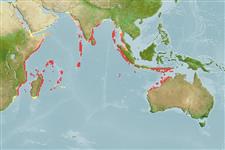>
Blenniiformes (Blennies) >
Blenniidae (Combtooth blennies) > Salariinae
Etymology: Blenniella: Diminutive of blennius, Greek,blenios = mucus (Ref. 45335).
More on author: Bleeker.
Environment: milieu / climate zone / depth range / distribution range
Ecologie
marien rifbewoner. Tropical
Indian Ocean: essentially restricted from African east coast to the west coast of Sumatra, and extending to Java and Bali.
Lengte bij maturiteit / Grootte / Gewicht / Leeftijd
Maturity: Lm ?, range 2 - ? cm
Max length : 8.1 cm SL mannelijk / geslacht onbekend; (Ref. 9962); 6.0 cm SL (female); common length : 6.0 cm SL mannelijk / geslacht onbekend; (Ref. 9962); common length :5.5 cm SL (female)
Korte beschrijving
Determinatiesleutels | Morfologie | Morfometrie
Dorsale stekels (totaal) : 12 - 14; Dorsale zachte stralen (totaal) : 19 - 22; Anale stekels: 2; Anale zachte stralen: 19 - 22; Wervels: 38 - 40. Diagnosis: Dorsal fin XII to XIV, 19 to 22, notched between spinous and segmented-ray portions; anal fin II, 19-22; pectoral rays 13-15 (usually 14); pelvic fin I, 3; caudal fin procurrent rays 10-14, segmented rays 13. Vertebrae 11-12 + 27-29. Last pleural rib on 12-13th vertebrae. Orbital cirrus simple filamentous; nasal cirri short and simple to palmate with 2-6 branches; nape without cirri. Lateral line, continuous anterodorsally below dorsal spine 6-7th to 9-10th, disconnected posteroventrally up to below dorsal spine 12-13th. Mandibular pores 4-6. Lips margin entire. Occipital crest present, higher in males (Ref. 9962). Body depth at anal-fin origin 5.6-6.1 in SL (Ref. 90102). Males with dusky bands on body, each band with a vertical pair of oblong spots; dark spot behind eye and opercle (Ref. 4404). Females with faintly dusky bands on body overlain by dark lines that break up into dashes at posterior portion; dark spots on median fins (Ref. 4404).
Oviparous. Eggs are demersal and adhesive (Ref. 205), and are attached to the substrate via a filamentous, adhesive pad or pedestal (Ref. 94114). Larvae are planktonic, often found in shallow, coastal waters (Ref. 94114). Common length: females usually less than 5.5 cm, males usually more than 6.0 cm in SL (Ref. 9962).
Oviparous, distinct pairing (Ref. 205).
Springer, V.G. and J.T. Williams, 1994. The Indo-West Pacific blenniid fish genus Istiblennius reappraised: a revision of Istiblennius, Blenniella, and Paralticus, new genus. Smithson. Contrib. Zool. 565:1-193. (Ref. 9962)
Status op de Rode Lijst van het IUCN (Ref. 130435)
Gevaar voor de mens
Harmless
Gebruik door de mens
Tools
Speciale rapporten
Download XML
Internetbronnen
Estimates based on models
Preferred temperature (Ref.
123201): 25.9 - 29.3, mean 28.2 °C (based on 721 cells).
Fylogenetische diversiteitsindex (Ref.
82804): PD
50 = 0.5020 [Uniqueness, from 0.5 = low to 2.0 = high].
Bayesian length-weight: a=0.00741 (0.00335 - 0.01640), b=3.02 (2.83 - 3.21), in cm total length, based on LWR estimates for this (Sub)family-body shape (Ref.
93245).
Trofisch niveau (Ref.
69278): 2.8 ±0.3 se; based on size and trophs of closest relatives
Weerstandsvermogen (Ref.
120179): Hoog, minimale populatieverdubbelingstijd minder dan 15 maanden (Preliminary K or Fecundity.).
Fishing Vulnerability (Ref.
59153): Low vulnerability (10 of 100).
